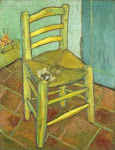
Living in Florida -- where there are really only two seasons, summer and not-summer -- it's easy to forget the first day of spring. Even the television weatherpersons announce the day in a blasé, bemused way, as if it's only a formality after weeks of temperatures hovering around 80.
But still, the arrival of spring deserves a special tribute, and what better than one of van Gogh's flowering orchard canvases from Arles? He painted over a dozen of them in late March-April 1888, pear, plum, apricot and peach trees, explosions of blooms and colors. Subconsciously they likely reflected his feeling of rebirth, arriving as he had in February after two difficult years in Paris. Quite consciously, they reflected Vincent's fascination with Japanese art: artists like Hiroshige made flowering trees a key motif in their ukiyo-e prints. Vincent knew these well, for many beautiful examples formed part of his and Theo's Japanese print collection. Vincent may also have been thinking of one of his heroes, Jean-François Millet, whose lovely "Spring" canvas had entered the Louvre in 1887, while Vincent was still in Paris. (Today "Spring" is in the Musée d'Orsay: see
Catherine Delors' blog for a tribute.)
I saw the Van Gogh Museum's collection of flowering orchards in 2007, but I chose my favorite at the Kröller-Müller Museum during that same trip to the Netherlands -- this one, "Peach Trees in Blossom," also known as the "Souvenir de Mauve" (click image to enlarge). I know I say this all the time, but a photograph cannot capture the colors and texture of this picture. It was easily my favorite painting in the entire Kröller-Müller. I could not tear my eyes away. The graceful arc of the tree trunk, the way the flowers stretch to the sky...lovely. Vincent himself thought it the best of the paintings he had done up to that point in Arles, and for that reason, he chose it to send to Jet Mauve, the widow of Dutch landscape painter Anton Mauve, when he learned of Mauve's death. Vincent had known Anton Mauve in The Hague; Mauve had been a mentor and teacher before the two had a falling-out over Vincent's relationship with prostitute Sien Hoornik. It is fair to say that Mauve's work and guidance helped shape Vincent's approach to landscape painting, and Vincent wrote to Theo that he was "choked with emotion" after hearing of Mauve's passing. In typical Vincent fashion, sending the painting to The Hague had a pragmatic angle too: he confided to Theo that the gift "might really break the ice in Holland," in other words, help gain exposure for his work in the brothers' homeland.
After choosing the painting to send, Vincent inscribed it "Souvenir de Mauve" (Remembrance of Mauve) together with "Vincent & Theo." But Theo's name is no longer there, and it is thought Vincent removed it at his brother's request. The painting has never been restored, but the colors are still fresh, whereas in some of the other orchard paintings Vincent's pinks have faded to white.
Happy Spring!






.jpg)




